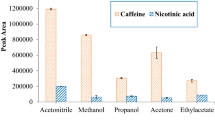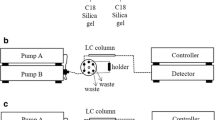Abstract
An automated sequential injection analysis spectrophotometric assay for the determination of purine alkaloids in coffee drinks was developed. The sample was treated with a carrez reagent for matrix suppression followed by filtration; subsequently, alkaloids were separated from organic acids using a short C18 monolithic column (10 × 4.6 mm). The flow rate of the separation step was 10 μL s−1 with 10% v/v of methanol as the mobile phase. The sum of alkaloids evaluated as caffeine was detected at 274 nm. The influence of the main parameters affecting the quantification of purine alkaloids was optimized. One sample analysis lasted 15 min when aspirated in triplicate. The linear range was 1–15 mg L−1, and the determination coefficient (r 2) was 0.9969. The limit of detection and limit of quantitation were 0.128 and 0.425 mg L−1, respectively. The repeatability evaluated as the relative standard deviation (RSD) was 3.58% (n = 12, 10 mg L−1). Under optimal conditions, the method was successfully applied to determine purine alkaloids in different real samples including soluble coffee, coffee from an espresso machine, and brewed coffee drinks.




Similar content being viewed by others
References
Alesso M, Fernández L (2016) Caffeine determination by flow injection analysis employing bovine serum albumin as a fluorophore. Microchem J 127:165–169. doi:10.1016/j.microc.2016.03.004
Belguidoum K, Amira-Guebailia H, Boulmokh Y, Houache O (2014) HPLC coupled to UV–vis detection for quantitative determination of phenolic compounds and caffeine in different brands of coffee in the Algerian market. J Taiwan Inst Chem Eng 45:1314–1320. doi:10.1016/j.jtice.2014.03.014
Bjarnadottir A (2016) How much caffeine in a cup of coffee? A Detailed Guide. https://authoritynutrition.com/how-much-caffeine-in-coffee/. Accessed 12 Dec 2016
De Kesel PMM, Lambert WE, Stove CP (2015) An optimized and validated SPE-LC–MS/MS method for the determination of caffeine and paraxanthine in hair. Talanta 144:62–70. doi:10.1016/j.talanta.2015.05.084
Dewani AP, Dabhade SM, Bakal RL, Gadewar CK, Chandewar AV, Patra S (2015) Development and validation of a novel RP-HPLC method for simultaneous determination of paracetamol, phenylephrine hydrochloride, caffeine, cetirizine and nimesulide in tablet formulation. Arab J Chem 8:591–598. doi:10.1016/j.arabjc.2013.09.040
Heydari R, Mousavi M (2016) Simultaneous determination of saccharine, caffeine salicylic acid and benzoic acid in different matrices by salt and air-assisted homogeneous liquid-liquid extraction and high-performance liquid chromatography. J Chil Chem Soc 61:3090–3094. doi:10.4067/S0717-97072016000300017
Salinas-Vargas ME, Canizares-Macías MP (2014) On-line solid–phase extraction using a C18 minicolumn coupled to a flow injection system for determination of caffeine in green and roasted coffee beans. Food Chem 147:182–188. doi:10.1016/j.foodchem.2013.09.134
Sereshti H, Samadi S (2014) A rapid and simple determination of caffeine in teas, coffees and eight beverages. Food Chem 158:8–13. doi:10.1016/j.foodchem.2014.02.095
Taverna D, Di Donna L, Bartella L, Napoli A, Sindona G, Mazzoti F (2016) Fat analysis of caffeine in beverages and drugs by paper spray tandem mass spectrometry. Anal Bioanal Chem 408:3783–3787. doi:10.1007/s00216-016-9468-1
Tefera M, Geto A, Tessema M, Admassie S (2016) Simultaneous determination of caffeine and paracetamol by square wave voltammetry at poly(4-amino-3-hydroxynaphthalene sulfonic acid)-modified glassy carbon electrode. Food Chem 210:156–162. doi:10.1016/j.foodchem.2016.04.106
Timofeeva I, Medinskaia K, Nikolaeva L, Kirsanov D, Bulatov A (2016) Stepwise injection potentiometric determination of caffeine in saliva using single-drop microextraction combined with solvent exchange. Talanta 150:655–660. doi:10.1016/j.talanta.2016.01.001
Tyszczuk-Rotko K, Beczkowska I (2015) Nafion covered lead film electrode for the voltammetric determination of caffeine in beverage samples and pharmaceutical formulations. Food Chem 172:24–29. doi:10.1016/j.foodchem.2014.09.056
Zheng H, Ni D, Yu Z, Liang P, Chen H (2016) Fabrication of flower-like silver nanostructures for rapid detection of caffeine using surface enhanced Raman spectroscopy. Sensors Actuators B Chem 231:423–430. doi:10.1016/j.snb.2016.03.045
Žiak L, Májek P, Hroboňová K, Čacho F, Sádecká J (2014) Simultaneous determination of caffeine, caramel and riboflavin in cola-type and energy drinks by synchronous fluorescence technique coupled with partial least squares. Food Chem 159:282–286. doi:10.1016/j.foodchem.2014.03.034
Author information
Authors and Affiliations
Corresponding author
Ethics declarations
Funding
The authors gratefully acknowledge the financial support provided by the Ministry of Education, Youth and Sports of the Czech Republic, specific research project No. SVV 260412. This publication was also supported by the STARSS reg. No. CZ.02.1.01/0.0/0.0/15_003/0000465 project co-funded by the ERDF.
Conflict of Interest
Mihalčíková L declares that she has no conflict of interest. Boonjob W declares that she has no conflict of interest. Sklenářová H declares that she has no conflict of interest.
Ethical Approval
This article does not contain any studies with human participants or animals performed by any of the authors.
Informed Consent
Not applicable.
Rights and permissions
About this article
Cite this article
Mihalčíková, L., Boonjob, W. & Sklenářová, H. Automated Sequential Injection Method for Determination of Caffeine in Coffee Drinks. Food Anal. Methods 11, 111–118 (2018). https://doi.org/10.1007/s12161-017-0982-3
Received:
Accepted:
Published:
Issue Date:
DOI: https://doi.org/10.1007/s12161-017-0982-3




